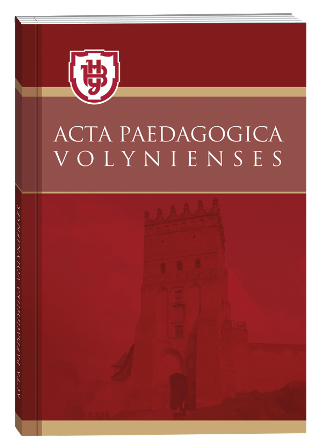EDUCATION OF THE EMOTIONAL CULTURE OF YOUTH THROUGH MUSIC
DOI:
https://doi.org/10.32782/apv/2022.5.11Keywords:
creative abilities, types of music activities, information and communication technologies, musical art, culture, general art, spiritual development of the personality, means of educationAbstract
The article notes that music affects personality at an early stage. It has been proven that music is one of the richest and most effective means of aesthetic education, has a great power of emotional impact, educates human feelings, and forms tastes. It is described that the problems of musical and aesthetic education in pedagogical science have almost always been conducted in parallel with the problems of social education and personality development. It has been proven that the feeling of beauty in a person largely determines the criteria for evaluating social phenomena. This regularity distinguishes the pedagogical practice of musical-aesthetic education from a number of foreign analogues and determines approaches to the development of tools for musical-aesthetic education of the young generation. It is noted that the processes of forming the musical and aesthetic culture of a person are not isolated, they determine the aesthetic attitude to any type of activity that a person is engaged in. It is noted that the attention to this process in the context of the introduction of the educational part of the standards is determined by the fact that ultimately a student with a developed musical and aesthetic culture is more receptive to educational moments. In the modern setting, the problem of the formation of the aesthetic culture of a person presupposes the existence of independent educational systems. It is proved that musical-aesthetic education is a type of aesthetic education based on musical material and music. The possibility of integration of music and speech in a single educational influence is described, and music ensures the realization of a person-oriented approach in such an activity. It is noted that musical-aesthetic education, along with other types, may become an independent direction, changing the status of its musical educational materials. It is described that musical art is able to influence the comprehensive development of the personality, encourage moral and aesthetic experiences, and form a desire to aestheticize the surrounding world. It has been proven that originally music filled people with joy and dispelled sadness. The impact of music is so strong that it can change people's behavior and customs.
References
Грищенко Т. Зміст і організація форми музично-естетичного виховання в гімназіях України: Перша половина 19 ст. Рідна школа. 2001. № 11. C. 67–69.
Кемеровська О. Мистецтво у розкритті творчого потенціалу дитини // Обдарована особистість: пошук, розвиток, допомога. Київ: Генезис, 2008. С. 150–154.
Михайличенко О.В. Загальні методи музичного навчання. Теоретичні питання культури, освіти та виховання: Зб. наук. пр. Вип.27. Київ: Видав. центр КНЛУ, 2004. С. 49–53.
Печерська Е. Удосконалювати музично-творчий розвиток дітей. Початкова школа. 2000. № 6. C. 15–18
Рева В. Естетичне виховання школярів у процесі сприйняття музики. Мистецтво та освіта. 2009. № 1. C. 4–8.
Рева В. Індивідуальні стратегії формування естетичного сприймання музики школярами. Мистецтво та освіта. 2006. № 1. C. 12–15.
Рудницька О. Мистецтво у контексті розвитку духовної культури особистості // Художня освіта і проблеми виховання молоді. Зб. наук, статей. Київ: Міносвіти України, УЗІМН, 2007. С. 3–11.
Сапожнік О. Музично-естетичне виховання: зміст і структурні компоненти. Рідна школа. 2002. № 12. C. 20–22.
Турчин Т. Естетичне виховання молодших школярів у позакласній роботі. Початкова школа. 2008. № 5. C. 16–17.
Чудак В. Музично-естетичне виховання молодших школярів. Початкове навчання та виховання. 2007. № 16–18. C. 15–20.







